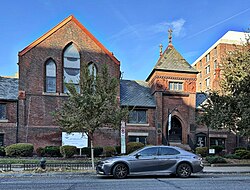
The Episcopal Diocese of Washington is a diocese of the Episcopal Church covering Washington, D.C., and nearby counties of Maryland in the United States. With a membership of over 38,000, the diocese is led by the Bishop of Washington, Mariann Budde. It is home to Washington National Cathedral, which is the seat of both the diocesan bishop and the Presiding Bishop of the Episcopal Church.

James Renwick Jr. was an American architect in the 19th century, noted especially for designing churches and museums. The Encyclopedia of American Architecture calls him "one of the most successful American architects of his time".

The Church of the Ascension and Saint Agnes is an Episcopal church building located at 1215 Massachusetts Avenue in Northwest Washington, D.C., US. The current structure built in 1874 as the Church of the Ascension was added to the National Register of Historic Places in 1984. In the late 1940s, the Church of the Ascension merged with the nearby St. Agnes Episcopal Church and adopted its present name, under which it has continued as an active parish in the Episcopal Diocese of Washington.

The Church of the Epiphany, built in 1844, is an historic Episcopal church located at 1317 G Street, N.W., in Washington, D.C. It was added to the National Register of Historic Places on September 10, 1971.
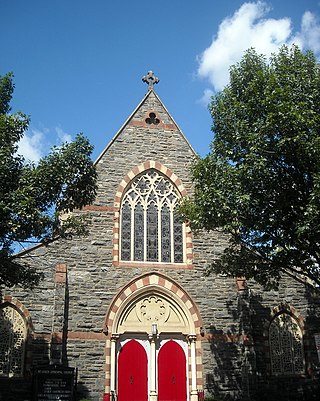
St. Luke's Episcopal Church is a historic Episcopal church located at 1514 15th Street, N.W., in Washington, D.C. Completed in 1879, it is home to the oldest African-American Episcopal congregation in the city. It was designated a U.S. National Historic Landmark in 1976 for its association with Rev. Alexander Crummell (1819–1898), a leading figure advocating black self-sufficiency and civil rights in the mid-19th century.

St. Mark's Episcopal Church, also known as St. Mark's, Capitol Hill, is a historic Episcopal church located at 3rd and A Streets, Southeast in the Capitol Hill neighborhood of Washington, D.C. Built 1888–1894, the church is an example of Gothic Revival and Romanesque Revival architectures.

St. Mark's Episcopal Church, now the Episcopal Parish of St. Mark and St. John, is a historic Episcopal church at 21 Race Street in Jim Thorpe, Carbon County, Pennsylvania. Completed in 1869, it is a prominent example of Gothic Revival architecture designed by that style's leading proponent, Richard Upjohn. It is one of Upjohn's last designs, and was funded by the congregation, which contained eight millionaires whose fortunes were made in the coal fields and railroad industry. It was added to the National Register of Historic Places in 1977, and declared a National Historic Landmark in 1987.
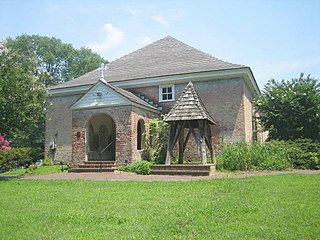
St. John's Church, St. John's Episcopal Church, or St. John's Episcopal Church, Broad Creek, is a historic Episcopal church located at 9801 Livingston Road in Fort Washington, Prince George's County, Maryland. It is a rectangular Flemish bond brick structure with a bell hipped roof. The interior features a barrel vaulted ceiling with an intricate support system.

The Oak Hill Cemetery Chapel, also known as the Renwick Chapel or James Renwick Chapel, is a historic building in the Georgetown neighborhood of Washington, D.C., United States. Designed by James Renwick, Jr. in 1850, Oak Hill Cemetery Chapel is the architect's only known example of Gothic Revival church architecture in Washington, D.C. It is located on the highest ridge in Oak Hill Cemetery, near the intersection of 29th and R Streets NW. The chapel is one of two structures in Oak Hill Cemetery listed on the National Register of Historic Places, the other being the Van Ness Mausoleum. The chapel, mausoleum, and cemetery are contributing properties to the Georgetown Historic District, a National Historic Landmark.

Concordia German Evangelical Church and Rectory, also known as Concordia United Church of Christ and Rectory is a historic church in Northwest, Washington, D.C. Concordia Church has been located in Foggy Bottom on the corner of G and 20th streets since 1833. The parsonage was built in 1885. The church building, located directly west of the parsonage, was dedicated May 15, 1892, and remains mostly in its original state. To the rear of the church, on its southern end, a three-bay Sunday School was added in 1899 and reconstructed in 1932. Founded as Concordia German Evangelical United Church, the congregation is now known as The United Church. It is a member congregation of the United Church of Christ and the United Methodist Church. It continues to offer German language services and events today, as well as in English.

Fletcher Chapel, also known as Church of God and the Saints of Christ Church, is a historic chapel located in Northwest, Washington, D.C.

Reedy Chapel A.M.E. Church is a historic African Methodist Episcopal (A.M.E.) church located at 2013 Broadway in Galveston, Texas. The church's congregation was founded in 1848 by enslaved African Americans and, following emancipation in 1865, the church was organized as Texas's first A.M.E. congregation in 1866. Reedy Chapel A.M.E. Church was one of locations of the public reading of General Order No. 3 by Union general Gordon Granger on June 19, 1865 which officially declared emancipation in Texas. The annual celebration of this declaration among African Americans continues today as the Juneteenth holiday.

Saint Paul's Episcopal Church is a historic building in Columbus, Ohio.

Saint Agnes Episcopal Church is a historic building located in Franklin, North Carolina, United States. It is a Chapel of All Saints Episcopal Church. From 1888 until 2014 St. Agnes was its own Episcopal Parish but in November of that year it officially merged with St. Cyprian's Episcopal Church to form an entirely new parish: All Saints Episcopal Church. All Saints is one congregation making use of two buildings: St. Agnes Chapel and St. Cyprian's Chapel. They use their website and Facebook to publish their worship schedule and keep parishioners and visitors up to date on where worship will be each Sunday.

St. Luke's Episcopal Church is a historic church at 309 E. Baltimore Street in Jackson, Tennessee, United States. The congregation was formed in 1832, the first of five new Episcopal congregations planted in West Tennessee that year after Mrs. Mary Hayes Willis Gloster of La Grange had traveled to Nashville to ask Bishop James H. Otey to bring the Episcopal Church to West Tennessee. The church building dates to 1845, although it was only partially completed that year. It was consecrated by Bishop Otey on May 14, 1853.
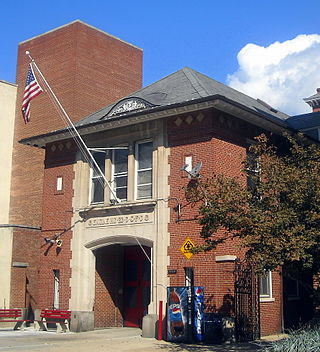
Engine Company 23 is a fire station and a historic structure located in the Foggy Bottom neighborhood of Washington, D.C. The two-story Italianate style building was a collaboration of the Washington, D.C. architectural firm of Hornblower & Marshall and District of Columbia Municipal Architect Snowden Ashford. It was built in 1910. The exterior of the structure features segmental-arched vehicle openings and quoined limestone frontispiece. It was listed on both the District of Columbia Inventory of Historic Sites in 2005 and on the National Register of Historic Places in 2007. The building sits on the campus of the George Washington University near Kogan Plaza.
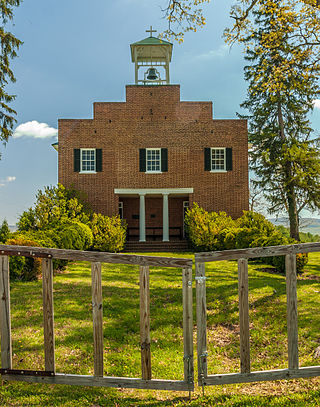
Wickliffe Church is a historic Episcopal church building located in Berryville, Clarke County, Virginia. The church has not been in active use since 1918, except for an annual homecoming service held in August and occasional special events.

St. Mark's Episcopal Church is a historic church complex at 73 Columbia Road in the Dorchester neighborhood of Boston, Massachusetts. The complex consists of three buildings: a chapel, rectory, and parish hall. All three were built between 1904 and 1909, with the last significant alteration to the exterior of the church occurring in 1916. All three buildings were designed by Edmund O. Sylvester, and present a unified architectural statement of Craftsman styling with some English Gothic detailing. The church complex was listed on the National Register of Historic Places in 2014.
